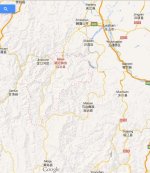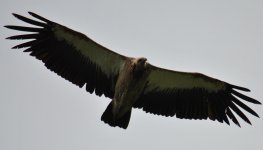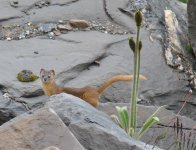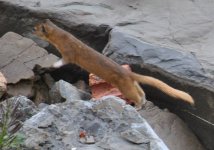china guy
A taff living in Sichuan
I’m home in Dujiangyan, between trips – have just completed 13 days in Qinghai and the day after tomorrow will turn around and head back west.
Best not tell how many birds we saw – lest I incur the wrath of other posters – but on this trip the most outstanding species included an immature Pallas’s Fish Eagle on a roadside lake (G214) to the south of Madoi and around 8 singing male Tibetan Buntings in the Kande Pass area (Tibetan Babax were found in the gorge area that leads to pass).
Also spent time in Xinghai area (35°35'19.01"N 99°59'16.68"E) where we found arid habit on the road that leads SE out of the town, towards the Yellow River, that gave fairly easy Desert Finch, Pied Wheatear, and Daurian Partridge – birds that we have found more difficult at sites such as Beishan park in Xining City. At around 3 hours from Xining and 2 hours from the Erla Pass – with at least 2 decent hotels – it makes for a useful stop.
This year we managed to avoid the primitive trucker stops, and their less than popular communal hole in the floor toilets, that have become infamous during Erla Pass visits, by using a newly opened hotel with en-suite sit-down WC’s and showers at Heka (35°53'47.63"N 99°59'23.82"E) – 1.5 hours south of the Erla Pass, these luxuries mean you have to swap the horror toilets for an hour’s earlier start after Tibetan Sandgrouse – which, for many birders, is an easy choice.
Yesterday I was looking at Roland’s list from a trip where he was birding the Jiuzhaigou area over July 4th, 5th and 6th. Interesting to note that in the park they saw Rufous-headed Robin (although a very poor and brief view for just a few of the party) and around Reed Lake a Tawny Fish Owl. Outside the park Per David’s Owl and Chinese Grouse were seen.
While in Qinghai it was interesting to read comments on other boards that were focused on this thread. To those I’d like to add my own –
1 – I hope this thread is perceived not just as an advertisement for my business but for other aspects of Sichuan birding – whether that involves my own projects, those of fellow guides, birders coming on organized tours or independent birders. Since I also have a life away from birding and am not the most energetic of extensive report writers some of information given may well sway towards the vague rather than highly detailed – but even a description like ‘north of Baxi’ has a use if you have a guide book that tells you the kind of habitat you need to find for the birds in question. The MacKinnon handbook may have its detractors but the habitat descriptions of many species are quite reliable. Google earth is also handy in focusing closer onto some of the areas I mention.
2 –a small and friendly community of birders has built up around the China Forum, where I think most of us realize the uses, limitations and potential dangers of this form of public networking. This particular thread has brought to notice sites that were formerly never part of the mainstream Sichuan birding circuit – Longcanggou being one, while this year at least three groups birded the Old Erlang Road. Post readers who’ve found access instructions to various sites vague, or want current info on certain birds or birding sites, often query each other in private by Birdforum PM or Email. I’ve both helped and been helped a lot via communication with birdforum contacts – but of course reserve the right to withhold info for birds that I believe vulnerable to disturbance. I’d recommend any China birder to use this form of information seeking – especially since the pace of tourist and other developments often leads major reports to be very quickly outdated.
3 – Lastly the poster who described my posts as self-aggrandizing has made fair comment – after all unless you’re a rabid lister who cares very little of how you get your bird as long as you get it, part of the enjoyment of birding must be the hunt. If each bird could equate to a trophy very few of us choose to hide their prizes under the bed – part of our sport is the gentle boasting over our lists and number of rare birds seen. If that’s seen as self-aggrandizing so be it – but at least in the process of blowing my own horn I must also be advertising the present quality of West of China birding, which, in the light of trying to increase an awareness of rich Chinese avian biodiversity, can’t be a totally bad thing????
Best not tell how many birds we saw – lest I incur the wrath of other posters – but on this trip the most outstanding species included an immature Pallas’s Fish Eagle on a roadside lake (G214) to the south of Madoi and around 8 singing male Tibetan Buntings in the Kande Pass area (Tibetan Babax were found in the gorge area that leads to pass).
Also spent time in Xinghai area (35°35'19.01"N 99°59'16.68"E) where we found arid habit on the road that leads SE out of the town, towards the Yellow River, that gave fairly easy Desert Finch, Pied Wheatear, and Daurian Partridge – birds that we have found more difficult at sites such as Beishan park in Xining City. At around 3 hours from Xining and 2 hours from the Erla Pass – with at least 2 decent hotels – it makes for a useful stop.
This year we managed to avoid the primitive trucker stops, and their less than popular communal hole in the floor toilets, that have become infamous during Erla Pass visits, by using a newly opened hotel with en-suite sit-down WC’s and showers at Heka (35°53'47.63"N 99°59'23.82"E) – 1.5 hours south of the Erla Pass, these luxuries mean you have to swap the horror toilets for an hour’s earlier start after Tibetan Sandgrouse – which, for many birders, is an easy choice.
Yesterday I was looking at Roland’s list from a trip where he was birding the Jiuzhaigou area over July 4th, 5th and 6th. Interesting to note that in the park they saw Rufous-headed Robin (although a very poor and brief view for just a few of the party) and around Reed Lake a Tawny Fish Owl. Outside the park Per David’s Owl and Chinese Grouse were seen.
While in Qinghai it was interesting to read comments on other boards that were focused on this thread. To those I’d like to add my own –
1 – I hope this thread is perceived not just as an advertisement for my business but for other aspects of Sichuan birding – whether that involves my own projects, those of fellow guides, birders coming on organized tours or independent birders. Since I also have a life away from birding and am not the most energetic of extensive report writers some of information given may well sway towards the vague rather than highly detailed – but even a description like ‘north of Baxi’ has a use if you have a guide book that tells you the kind of habitat you need to find for the birds in question. The MacKinnon handbook may have its detractors but the habitat descriptions of many species are quite reliable. Google earth is also handy in focusing closer onto some of the areas I mention.
2 –a small and friendly community of birders has built up around the China Forum, where I think most of us realize the uses, limitations and potential dangers of this form of public networking. This particular thread has brought to notice sites that were formerly never part of the mainstream Sichuan birding circuit – Longcanggou being one, while this year at least three groups birded the Old Erlang Road. Post readers who’ve found access instructions to various sites vague, or want current info on certain birds or birding sites, often query each other in private by Birdforum PM or Email. I’ve both helped and been helped a lot via communication with birdforum contacts – but of course reserve the right to withhold info for birds that I believe vulnerable to disturbance. I’d recommend any China birder to use this form of information seeking – especially since the pace of tourist and other developments often leads major reports to be very quickly outdated.
3 – Lastly the poster who described my posts as self-aggrandizing has made fair comment – after all unless you’re a rabid lister who cares very little of how you get your bird as long as you get it, part of the enjoyment of birding must be the hunt. If each bird could equate to a trophy very few of us choose to hide their prizes under the bed – part of our sport is the gentle boasting over our lists and number of rare birds seen. If that’s seen as self-aggrandizing so be it – but at least in the process of blowing my own horn I must also be advertising the present quality of West of China birding, which, in the light of trying to increase an awareness of rich Chinese avian biodiversity, can’t be a totally bad thing????
Last edited:










